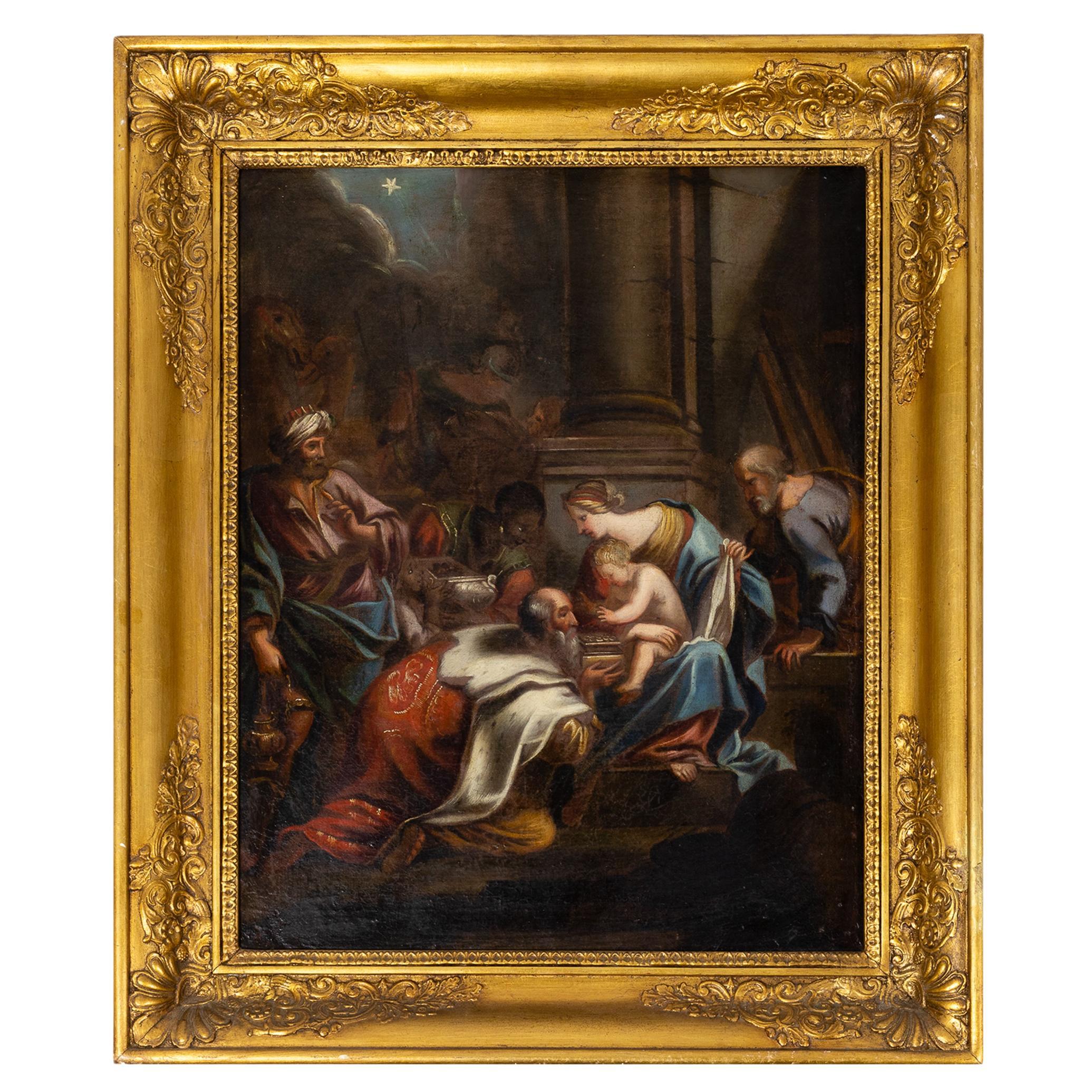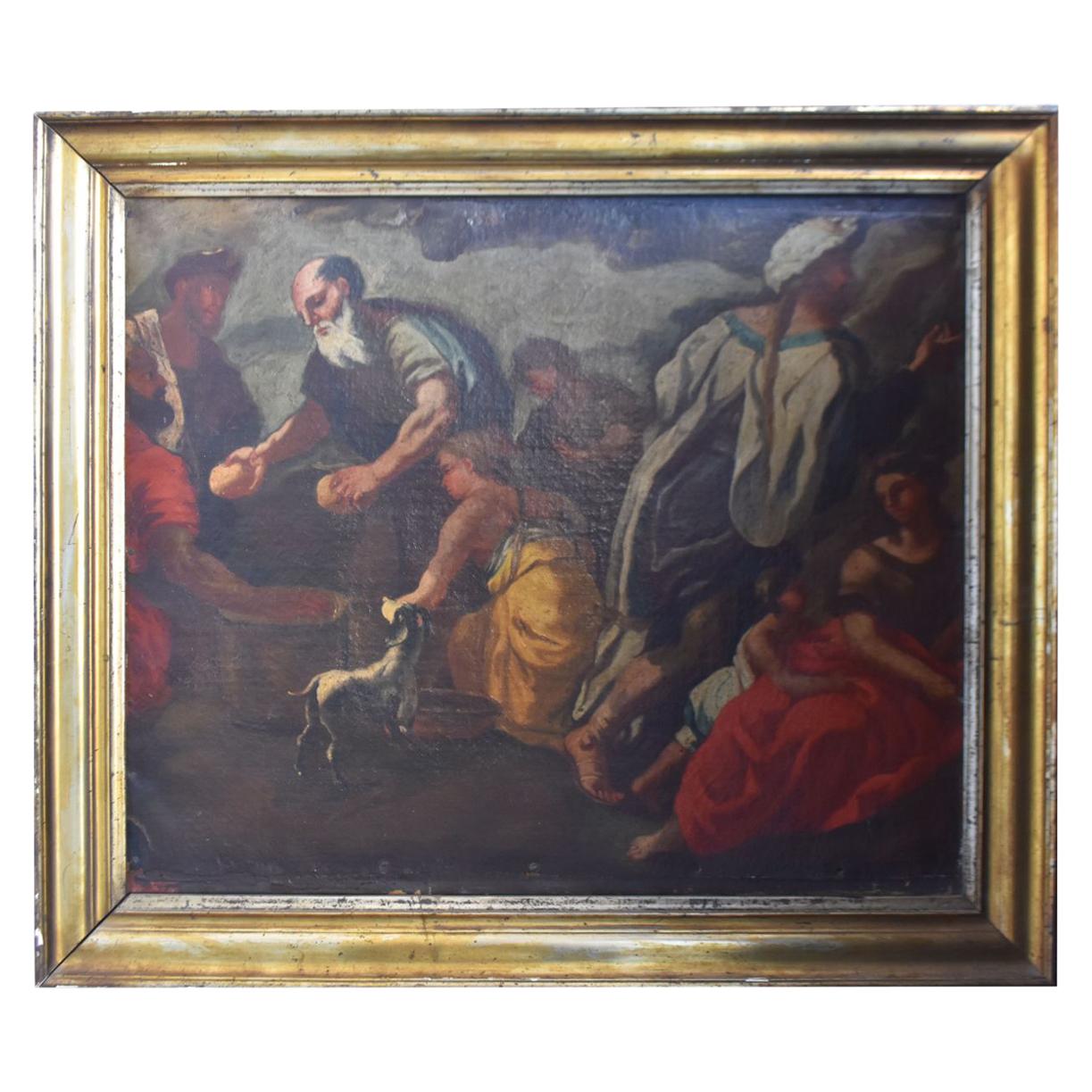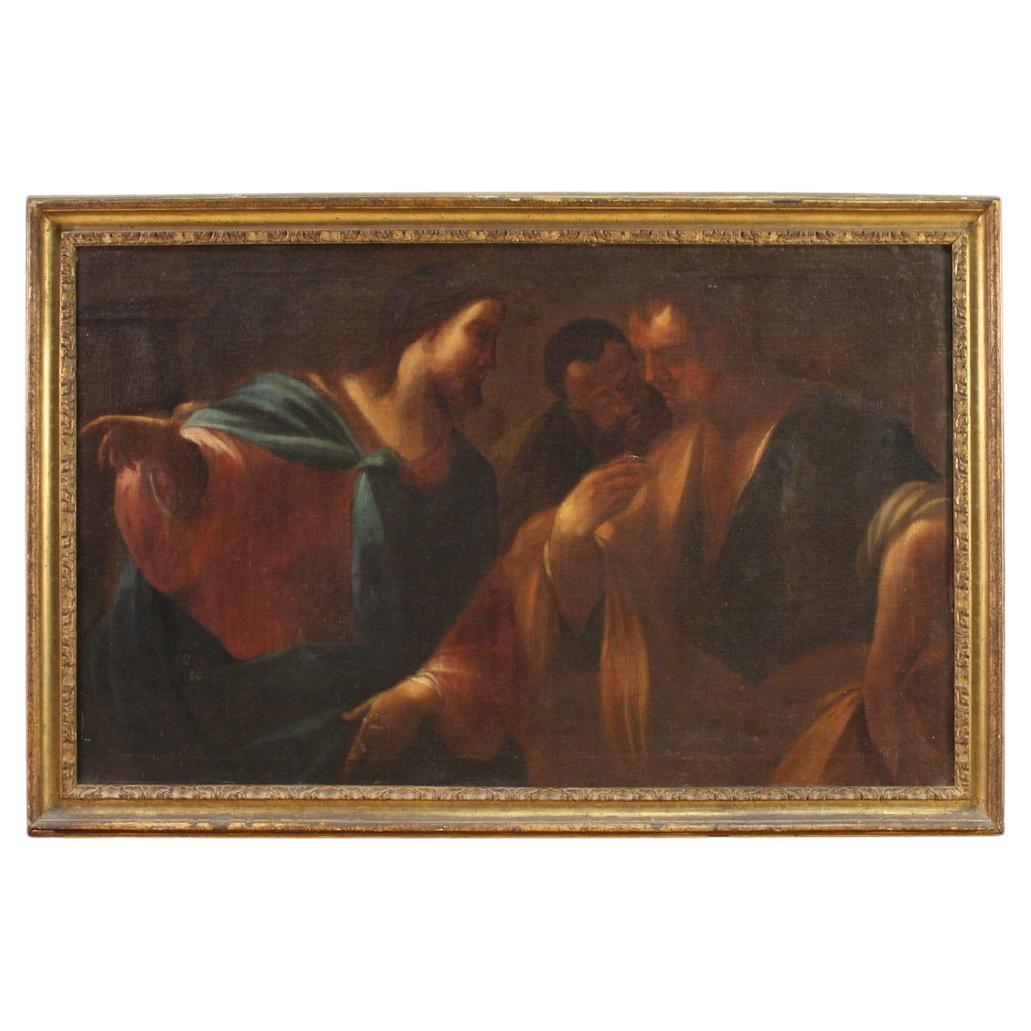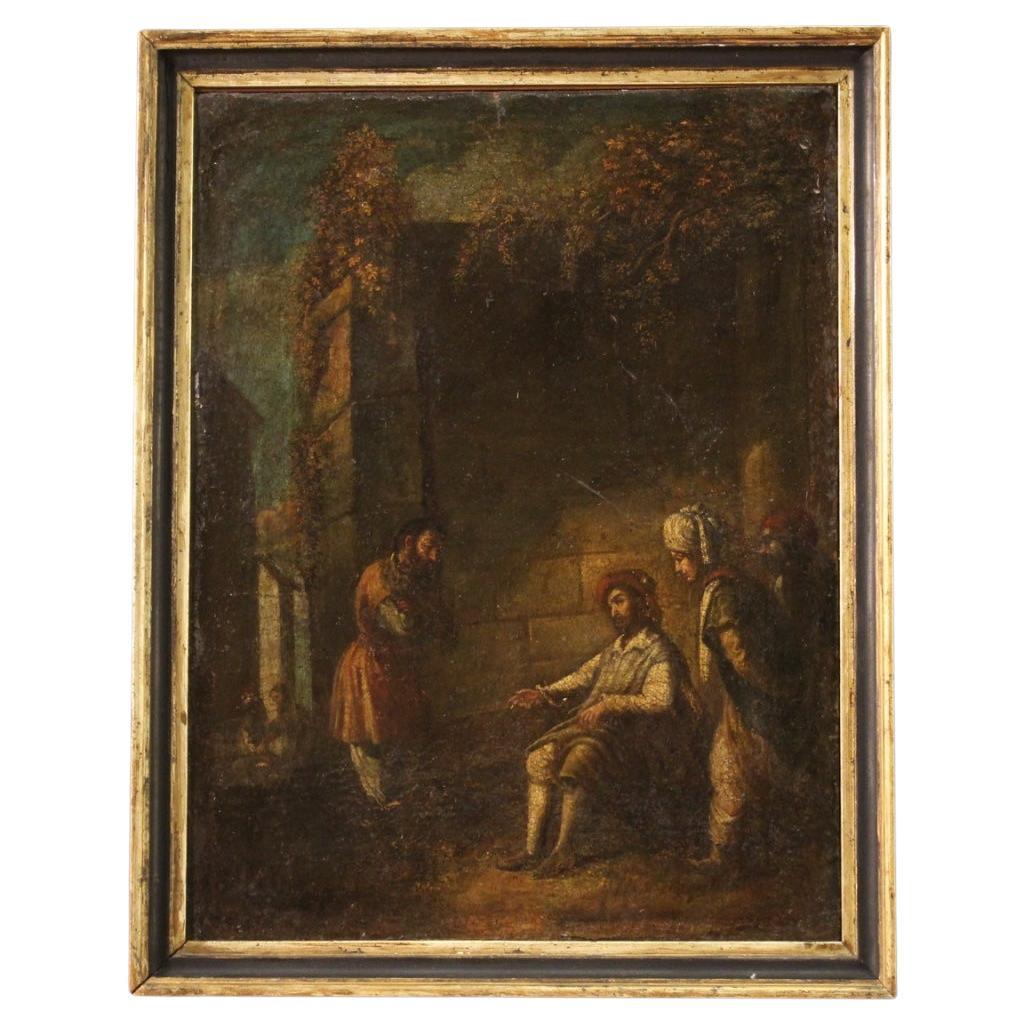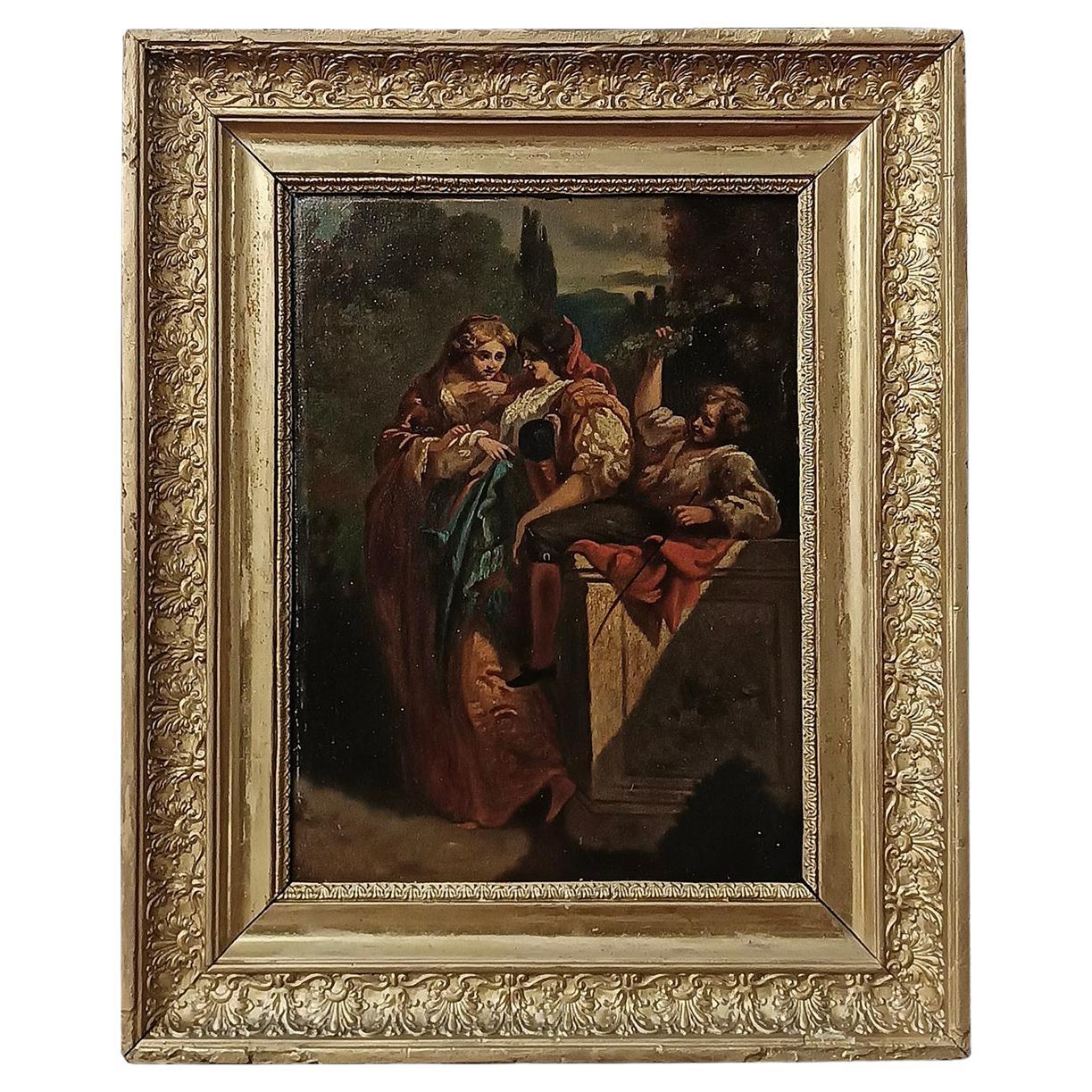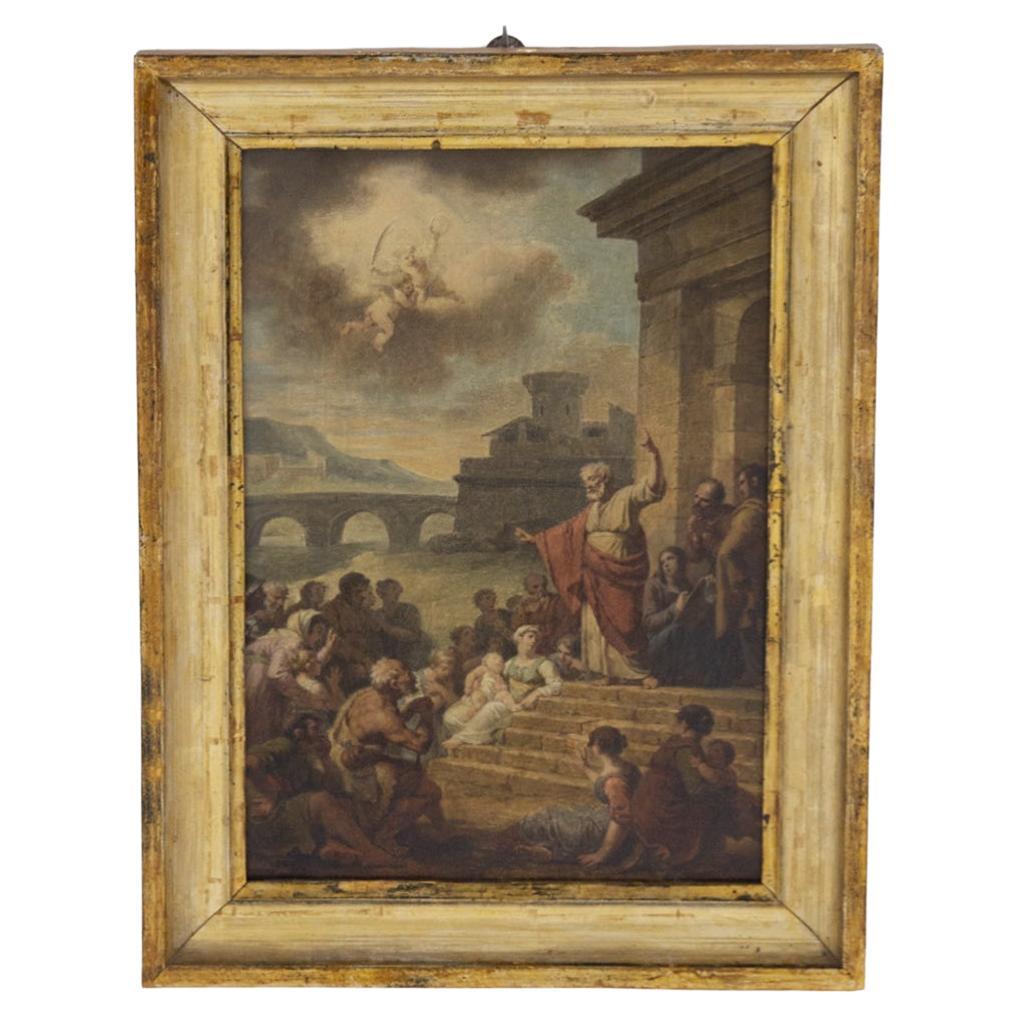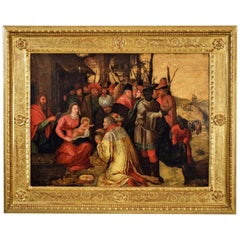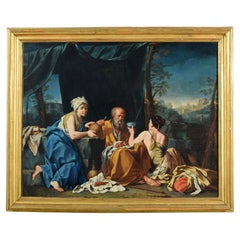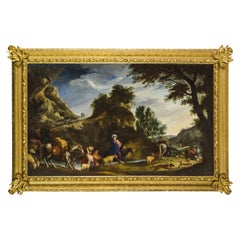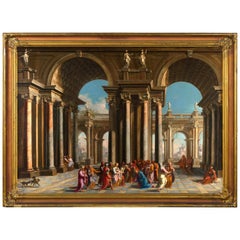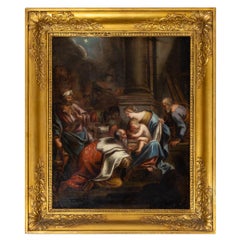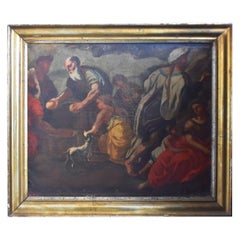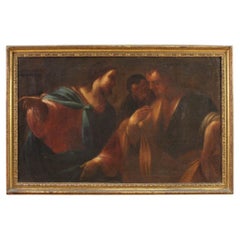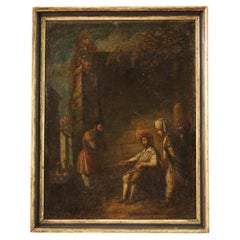Items Similar to 18th Century, Italian painting with Saint Nicholas and the miracle of the brick
Want more images or videos?
Request additional images or videos from the seller
1 of 21
18th Century, Italian painting with Saint Nicholas and the miracle of the brick
$17,373.08
£12,933.13
€14,500
CA$23,796.78
A$26,467.21
CHF 13,820.36
MX$322,077.83
NOK 176,507.04
SEK 165,532.46
DKK 110,383.44
Shipping
Retrieving quote...The 1stDibs Promise:
Authenticity Guarantee,
Money-Back Guarantee,
24-Hour Cancellation
About the Item
18th Century, Italian painting with Saint Nicholas and the miracle of the brick
Oil on canvas; Frame cm H 136 x W 109 x D 10. Canvas cm H 100 x W 74
The oil on canvas painting, with a seventeenth-century style moulded lacquered and gilded wood frame, depicts Saint Nicholas who participates in the council of Nicea and defends the dogma of Trinity through the miracle of the brick. The subject is rarely treated in painting and refers to the alleged presence of Saint Nicholas of Myra (today Bari - Italy) at the Council of Nicaea of 325 in the presence of the emperor Constantine. According to tradition, during the council Saint Nicholas would have strongly condemned Arianism, defending orthodoxy and making a miracle.
The first ecumenical council of the Christian world was the wish of the emperor Constantine I, concerned with the internal religious dissensions that occurred when the doctrine of the priest Arius of Alexandria in Egypt spread, which excluded the divinity of Jesus, Claiming that only the Father is truly God, while the Son is not eternal, he was born in time: before being created by the Father his did not exist.
The bishops of the empire took part in the council and it is assumed that Saint Nicholas also participated, considering the short distance between Myra and Nicaea and the fame he already enjoyed. In his "Historia di S. Nicolò" (Naples 1620) the historian and theologian Antonio Beatillo reports that to put an end to the discord about the nature of the Trinity, Nicola took a brick in hand and explained that to compose it are earth, water and fire: but this doesn’t contradict the fact that the brick exists as a brick. The same was to be understood for the Father, the Son and the Holy Spirit, merged in the Trinity. The miracle happened: from the brick "a flame flashed that rose to heaven, water gushed on the ground, clay remained in his hands".
The painting describes exactly the miraculous moment from which, from the brick held by Saint Nicholas and placed in the center of the composition, the fire is lit above and water flows to the ground. Around, the other bishops, identifiable by the mitria they carry on their head, the other religious and philosophers, assist surprised. On the right, standing high above a low relief sculpted architectural element, there is Constantine, who reacts with astonishment to the miracle, pointing at the brick with his left arm. The scene takes place inside a building with fluted columns and a voluminous drape theat to emphasize the importance of the throne.
The painting, of beautiful artistic quality, is the work of a painter active in Naples in the eighteenth century, as suggested by the analysis of the style with which the composition and expressiveness of the characters are resolved. The work, besides being significant for the rare subject and of historical-theological value, is also decorative thanks to the use of a vibrant and well-balanced color palette.
We apologize for any translation errors from the Italian.
- Dimensions:Height: 53.55 in (136 cm)Width: 42.92 in (109 cm)Depth: 3.55 in (9 cm)
- Style:Baroque (Of the Period)
- Materials and Techniques:
- Place of Origin:
- Period:
- Date of Manufacture:18th Century
- Condition:Wear consistent with age and use.
- Seller Location:IT
- Reference Number:1stDibs: LU4405241541552
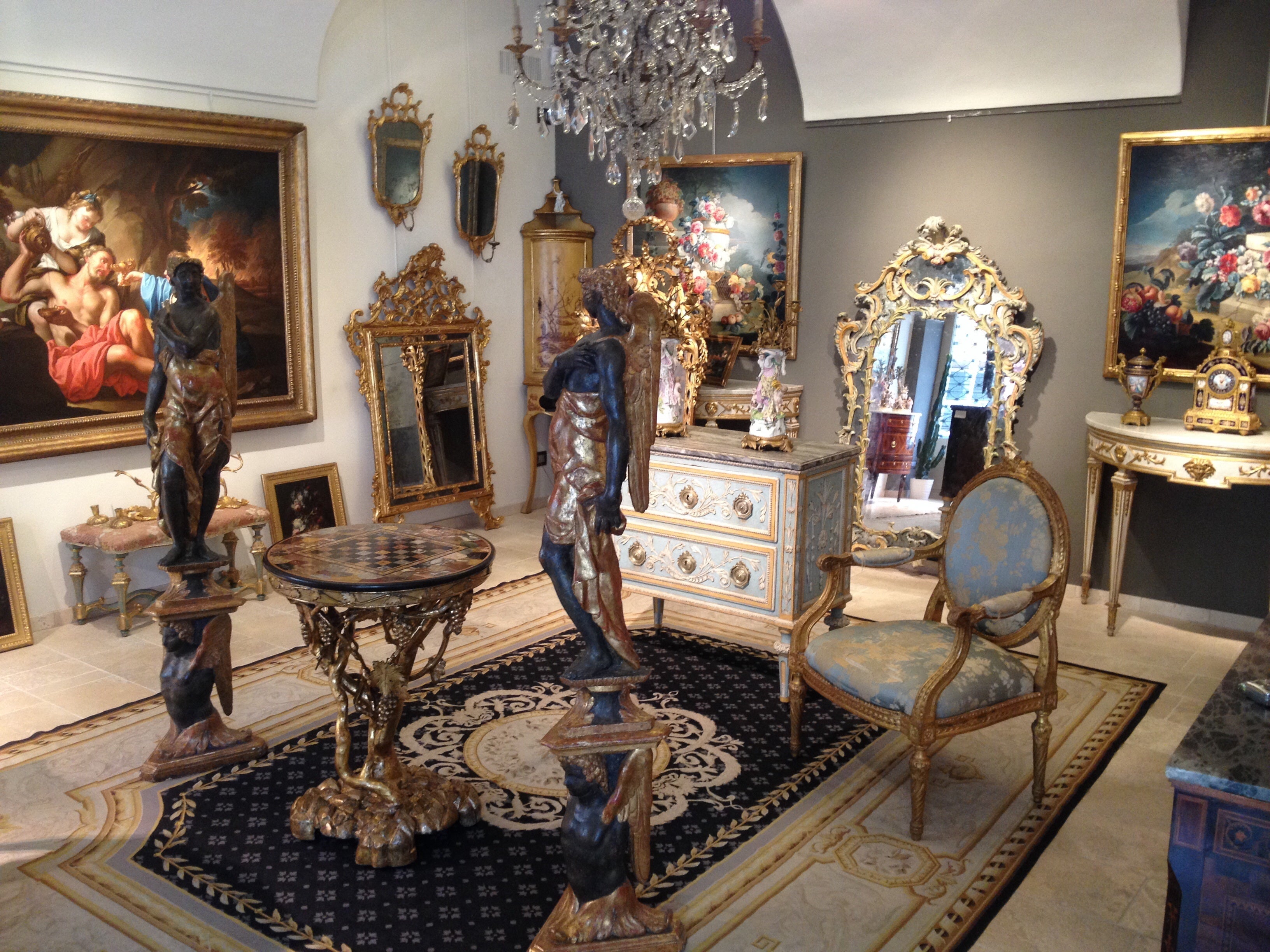
About the Seller
5.0
Platinum Seller
Premium sellers with a 4.7+ rating and 24-hour response times
Established in 1980
1stDibs seller since 2019
56 sales on 1stDibs
Typical response time: 1 hour
- ShippingRetrieving quote...Shipping from: Italy
- Return Policy
Authenticity Guarantee
In the unlikely event there’s an issue with an item’s authenticity, contact us within 1 year for a full refund. DetailsMoney-Back Guarantee
If your item is not as described, is damaged in transit, or does not arrive, contact us within 7 days for a full refund. Details24-Hour Cancellation
You have a 24-hour grace period in which to reconsider your purchase, with no questions asked.Vetted Professional Sellers
Our world-class sellers must adhere to strict standards for service and quality, maintaining the integrity of our listings.Price-Match Guarantee
If you find that a seller listed the same item for a lower price elsewhere, we’ll match it.Trusted Global Delivery
Our best-in-class carrier network provides specialized shipping options worldwide, including custom delivery.More From This Seller
View AllFrans Franken III 16th Century Oil on Wood, Adoration of the Magi, Painting
By Frans Franken the Younger
Located in IT
Frans Franken III and aid, Adoration of the Magi
Good condition
The oil painting on wood, with a gold background, depicts an Adoration of the Magi. The Magi are dressed in sumptuous silk and brocade dresses; they wear precious hats and jewelery. The richness of their garments is in contrast with the humility of the Holy Family and of the other characters who, around curious, observe the scene. The hut is simple, made of wood and straw: above it shines the Comet, symbol of the divine event. In the distance, a group of wayfarers walk along a path that is lost on the horizon, blending into the gold of the bottom.
The representation proposes a traditional iconography, in which the painter inserts some details that he lends himself to symbolic interpretations. Among these is the appearance of the Magi, who from the XIVth century differs iconographically: the wise astronomers represent the homage to Jesus of the then known parts of the world, namely Africa, Asia and Europe. To the right of the Magi, in the foreground, sits a monkey, considered a demonic creature and a symbol of lies and sin. It is depicted on the sidelines, as a defeat, next to a fragment of a classical column: ruin alludes to the end of paganism, of the old world that collapses with the advent of the new one, marked by the birth of Christ and liberation from the Original Sin. On the ruins he climbs the ivy, symbol of the immortality of the soul. The work is attributable to the workshop of the Flemish painter Frans Francken III...
Category
Antique 16th Century Belgian Renaissance Paintings
Materials
Paint
18th Cent., Italian Painting, Loth and the daughters, att. to Giuseppe Gambarini
By Giuseppe Gambarini
Located in IT
Giuseppe Gambarini (Bologna, 17 March 1680 - Casalecchio di Reno, 11 September 1725)
Loth and the daughters
Oil on canvas; Measurements: cm H 73 x W 93; frame H 88 x W 108 x D 5,5
The painting, of beautiful pictorial quality, depicts the biblical scene of Lot and his daughters, with Sodom set on fire in the background, and is stylistically attributable to the italian painter Giuseppe Gambarini (Italy, Bologna, 17 March 1680 - Casalecchio di Reno, 11 September 1725).
The canvas shows in the center Lot sitting and already drunk, depicted according to traditional iconography, old, gray and with long gray boat. With his left hand he grabs the wine flask that one of his daughters offers him. She is depicted kneeling and resting on large boulders of stone, described as an architectural base, dressed in a voluminous deep blue mantle, her hair covered with a humble headdress made of a knotted cloth; look at the viewer, as if to want to involve him directly in the scene. The other daughter is described on the left, from the back to the observer, with a bare back and dark hair gathered by a red ribbon. She too is intent on serving her father a cup in which to pour the wine. Around them a duck placed on a cloth, some bread and another wine flask enrich the composition describing a banquet in progress. The scene is set outdoors, where only a large tent supported by branches arranged in a hut serves as a shelter to the figures. In the background a forest landscape blends chromatically with the blue sky. To the right in the distance, is described the city of Sodom, already destroyed and on fire. Lot’s wife...
Category
Antique Early 18th Century Italian Baroque Paintings
Materials
Canvas
$22,045 Sale Price
20% Off
17th Century, Italian Painting by Pier Francesco Cittadini, Jacob and his Family
Located in IT
Pier Francesco Cittadini (Milan, 1616-Bologna, 1681)
"Jacob and his family go to Egypt"
Oil on canvas, cm 109 x 190 (canvas only)
The valuable painting, made in oil on canvas, depicts Jacob and his family go to Egypt and we believe it can be, given the high quality painting, autograph work of Italian Pier Francesco Cittadini (Italy Milan, 1616 - Bologna, 1681) made after 1647. The work, in excellent condition is accompanied by a coeval frame in wood finely carved and golden.
The scene depicted, which was confused with the Flight to Egypt in the past years, is instead identified with the biblical episode of Jacob’s journey. In the foreground, reading the painting from left to right, we see a caravan composed of animals, including donkeys, dromedaries, goats, dogs and horses and people, women, men and slaves, who carry on their journey along the banks of a river, following a path that to the right, would seem to lead to the through of a bridge. In addition to the watercourse is described an environment characterized by large rocks and impervious come far to cover the entire verticality of the canvas. On the left, in the distance, we see the tail of the caravan that runs along the steep path. Large trees enliven and harmonize the environment, as well as white and grey clouds characterize the predominantly clear sky and illuminated on the right by sunlight.
The story is told in the Bible, Book of Genesis, 30, 25, passage in which is described the flight of Jacob from Haran after the contrasts with Laban, father of his wife Rachel. Jacob is the third great patriarch of the Bible. From his descendants originate the twelve generations of the people of Israel. He is the son of Isaac and Rebekah, who led him to flee from the wrath of Esau to Haran to seek refuge from his brother, Laban. At his uncle’s house Jacob met his daughter Rachel. As soon as he saw his cousin, Jacob was taken. Jacob will stay seven years in the service of Laban to marry his beloved Rachel. But Laban, with a deception, will give him in marriage first Lia, the least beautiful eldest daughter, and only after another seven years the splendid Rachel. From his first wife he will have several children, while Rachel will give birth to the beloved son, Joseph, who will become viceroy of Egypt.
After years of service, Jacob asked to be paid with every dark-coloured garment among the sheep and every spotted and dotted garment among the goats. Laban accepted and sent away from his sons all the leaders of that kind. So Jacob took fresh branches of poplar, almond and plane tree, and flayed them, and put them in the troughs. The optical suggestion induced the goats and the sheep to conceive and give birth to dark, striped and dotted garments. He also ensured that all the strongest and healthiest leaders of the flock of Laban would drink near the barked branches, thus assuring a genetic superiority to his part of the flock. His flocks grew numerous and strong and he became richer than his relative, arousing envy. It was clear that Laban would not respect him much longer. At the suggestion of the Lord, Jacob decided to return to Canaan. Trying to avoid any possible dispute, he left with his family while Laban was absent for shearing sheep. But when, three days later, his uncle returned home, he became angry, feeling offended because Jacob had gone secretly and had not allowed him to greet his daughters and grandchildren. In addition, his teraphim, statuettes, or idols, which depicted the family deities, had disappeared. After 7 days of pursuit, Laban and his men reached Jacob’s group on Mount Gilead, in the mountainous region west of the Euphrates River, where his uncle and grandson had a stormy conversation. The younger man was outraged at being accused of stealing idols and told Labano to rummage through his family’s tents at will. Neither of them could know or even imagine that it was Rachel who took the idols and hid them in the saddle of the camel. During the search, she sat down firmly on the saddle, apologizing for not being able to get up, «because I usually have what happens to women» (Gen 31:35). So the loot wasn’t discovered.
The author of this work was inspired by the composition of an engraving by Stefano Della Bella (1610-1664) of circa 1647. The engraving by Stefano della Bella bears the title "Iacob sur ses vieux jours quitte sans fascherie pour voir son filz Ioseph, sa terre et sa patrie" and is signed on the bottom left "Stef. of the Beautiful In. et fe." while on the right it is declared "Cum privil. Regis", that is with license of the king.
Stefano Della Bella (Italy - Florence, May 18, 1610-Florence, July 12, 1664) was born in a family of painters, sculptors and goldsmiths and was left early orphan of his father sculptor, he dedicated himself first to the art of goldsmith at the school of Giovanni Benedetto Castiglione and Gasparo Mola, then turning his attention to drawing and engraving. He soon began drawing figures and copying the etchings of Jacques Callot, which inspired his early works. Under the protection of the Medici, in particular of Don Lorenzo, cadet son of Grand Duke Ferdinand I, Della Bella has the opportunity to make study trips to Rome, where he stayed from 1633-1636; In Rome he met French engravers and publishers of prints such as Israël Henriet and François Langlois, who influenced his decision to move to Paris in 1639, four years after the death of Callot. In Paris he soon reached, thanks to the engravings commissioned by Cardinal Richelieu, the success also worldly; he frequented courtiers, theatre artists and writers, while refusing too oppressive honors. In 1646-1647 he continued his travels in the Netherlands to Amsterdam, Antwerp and Dordrecht. He returned to Florence in 1650 and resumed working under the protection of the Medici court, working for his patrons. In 1656 he became a member of the Academy of Apatists.
The painting object of this study is reasonably attributable to Pier Francesco Cittadini, or Pierfrancesco Cittadini, called the Milanese or the Franceschino (Italy - Milan, 1616-Bologna, 1681) as some exemplary stylistic comparisons proposed to follow can prove.
Pier Francesco Cittadini was an Italian baroque painter, mainly active in Bologna.
His artistic training first took place with the painter Daniele Crespi...
Category
Antique Mid-17th Century European Baroque Paintings
Materials
Canvas, Giltwood
Alberto Carlieri, Capriccio with Christ and the Adulteress, Oil on Canvas
By Alberto Carlieri
Located in IT
Alberto Carlieri (Italy-Roma 1672-1720), "Christ and the adulteress",
Oil on canvas, with frame cm H 115 x L 151 x 6.5, only canvas H 98.5 x L 135 cm...
Category
Antique Late 17th Century Italian Baroque Paintings
Materials
Canvas
18th Century, Italian painting Depicts Bambocciata by Giovanni Michele Graneri
Located in IT
Giovanni Michele Graneri (Italy, Turin 1708-1762)
Bambocciata (Farmers dancing in front of the inn)
The painting, made in oil on canvas, depicts a moment of celebration where some p...
Category
Antique Mid-18th Century Italian Baroque Paintings
Materials
Canvas
18th Century, Italian painting with Sacred Heart of the Child Jesus by Pietro Ba
By Pietro Bardellino
Located in IT
Pietro Bardellino (Italy - Naples, 1732 - 1806), attr., Sacred Heart of the Child Jesus
Measurements: with frame, cm L 86 x H 99 x P 8; only the canvas, cm L 78 x H 64
The painting, made in oil on canvas, represents the Sacred Heart of the Child Jesus. Stylistically the work is attributable to Pietro Bardellino (Italy, Naples, 1732 - Naples, 1806), a pupil of Francesco De Mura and considered by critics one of the most gifted and sensitive exponents of the Rococo style in Naples.
The canvas represents the Child Jesus, surrounded by flowers in an outdoor setting, while showing the sacred heart. The canvas has a well-balanced color and a strong sweetness of the child’s traits, which with the complicit gesture of the right hand, involves the viewer in the intimate and delicate sharing of the garden in which he sits. The roses, in addition to being a beautiful piece of still life, contribute to enrich the Christological message, being bearers of symbolic meanings. Marian attributes par excellence, are often side by side with Christ, whose thorns foreshadow the Passion. In the canvas, on the top left, two cherubim are observed: among them, according to the Old Testament, is God: the author therefore puts into place an iconographic and iconological hyperbole that amplifies its meaning. The iconographic theme of the Child Jesus with the Sacred Heart in his hand spread between the second half of the eighteenth century and the first of the following century. With the worship of the Sacred Heart of Jesus, the Catholic Church intends to honour the Heart of Jesus Christ, one of the organs symbolizing his humanity, which by intimate union with the Divinity, has the right to worship and love of the Saviour for men, of which His Heart is the symbol. It represents one of the fundamental devotions of Christian life, as it manifests the true face of God, who is prodigal and boundless love. It was the French mystic Saint Margaret Mary Alacoque...
Category
Antique Mid-18th Century Italian Baroque Paintings
Materials
Canvas
You May Also Like
Adoration of the Magi Paiting, Italian Baroque Religious Art, 18th Century
Located in Lisbon, PT
This 18th century Italian painting captures one of the most iconic biblical moments: the Adoration of the Magi.
The mysterious travelers kneel in reverence before the Infant Jesus, ...
Category
Antique 18th Century Italian Baroque Paintings
Materials
Canvas
$9,476 Sale Price
20% Off
17th Century Italian School Biblical Scene
Located in Marseille, FR
17th century oil on canvas representation of the "Feeding of the 4,000" of Italian school.
Category
Antique 17th Century French Baroque Paintings
Materials
Canvas
17th Century Oil on Canvas Italian Antique Religious Painting The Tribute Money
Located in Vicoforte, Piedmont
Antique religious painting from the second half of the 17th century. Oil on canvas artwork, first canvas, depicting the Tribute Money. In fact, there was a tax for the maintenance of...
Category
Antique 1680s Italian Paintings
Materials
Canvas
$6,709 Sale Price
20% Off
Free Shipping
17th Century Oil on Canvas Italian Religious Painting The Unfaithful Farmer 1680
Located in Vicoforte, Piedmont
Antique Italian painting from the 17th century. Artwork oil on canvas depicting a particular religious subject, the Parable of the unfaithful farmer. Once upon a time there was a farmer who fraudulently administered his master's assets. Before being fired, he tries to recover part of the credits by making important discounts to creditors, who will be grateful to him. The master, instead of condemning this behavior which is detrimental to him, praises the cunning of the farmer. This story is meant to urge believers to do whatever is necessary before the imminent arrival of the Kingdom of God and its judgment. Painting that develops vertically adorned with a wooden frame not coeval carved, lacquered and gilded. Painting that focuses on the characters in the foreground, a patina that does not allow a perfect view of the architecture and of the foreshortening on the left (see photo), painted to be cleaned...
Category
Antique 1680s Italian Paintings
Materials
Canvas
$2,875 Sale Price
20% Off
Free Shipping
LATE 18th CENTURY SMALL PAINTING WITH A GENRE SCENE
Located in Firenze, FI
A delightful small painting, framed in a contemporary frame in carved and gilded wood, depicting a lively genre scene. In the background, an Italian garden opens up to reveal two you...
Category
Antique Late 18th Century French Paintings
Materials
Canvas, Wood, Paint
Antique Canvas Depicting 'The Preaching of St. Peter'
Located in Milano, IT
Beautiful framed wooden canvas from the end of the 19th century.
The reference narrative is the one found in the Acts of the Apostles (Acts 2:14-42) in which Saint Peter starts pre...
Category
Antique Early 1900s Italian Romantic Paintings
Materials
Canvas, Wood
$6,230 Sale Price
20% Off
More Ways To Browse
Gilded Throne
Egyptian Throne
Seven Gods
Shoe Horn
Spanish Brass Chest
Sutton Place
Swedish Gustavian Nightstand
Tibetan Coral
Used Bathroom Wall Cabinet
Used Curio Cabinet With Light
Used Double Entry Doors
Used Furniture Cheltenham
Used Furniture New Bedford
Used Hookahs
Used Platform Bed Frame
Victorian Gong
Vintage Aircraft Seat
Vintage Brutalist Rings
